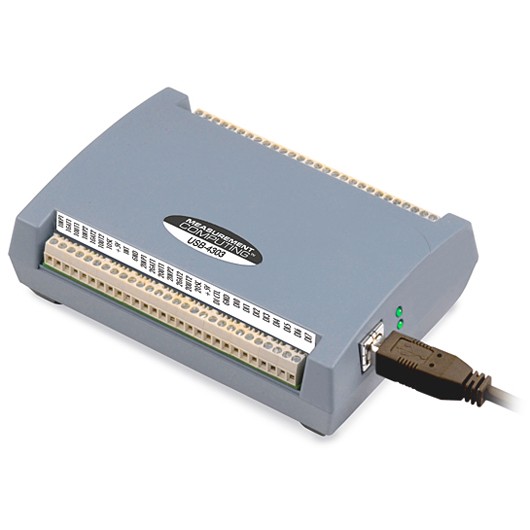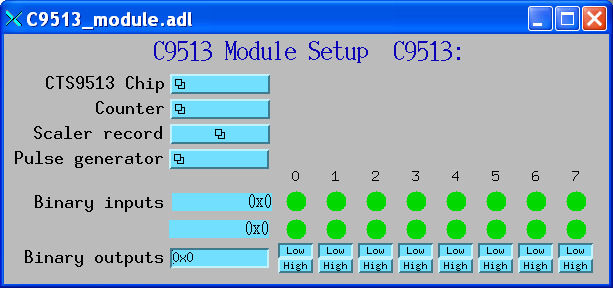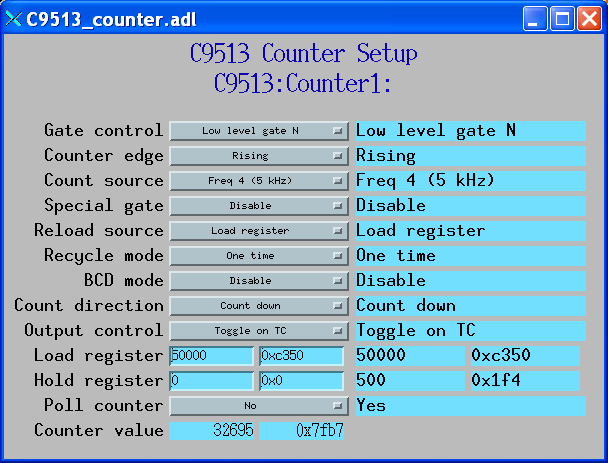Photo of USB-4303

NOTE: The Measurement Computing USB-4303 is no longer available. It has been replaced with the USB-CTR04/08 which has higher performance and more features.. See the documentation for the EPICS measCompUSBCTR driver for more information.
This is an EPICS driver for the USB-4303 counter/timer module from Measurement Computing The driver should also work with other Measurement Computing devices that are based on the C9513, including the discontinued PCI-CTR10, CIO-CTR10, and PC104-CTR10, but this has not been tested. The driver is written in C++, and consists of a class that inherits from asynPortDriver, which is part of the EPICS asyn module.

This module has the following features:
The CTS9513 chip is extremely flexible. It is beyond the scope of this document to explain the features of the CTS9513. The CTS9513 manual describes all of the chip's features and functions in detail.
The following is the main medm screen for controlling the USB-4303.

The following lines are needed in the EPICS startup script for the USB-4304 or other CTS9513 board.
## Configure port driver
# C9513Config(portName, # The name to give to this asyn port driver
# boardNum, # The number of this board assigned by the Measurement Computing Instacal program
# numChips) # The number of CTS9513 chipts on this board
C9513Config("C9513_1", 0, 2)
dbLoadTemplate("C9513.substitutions")
The measComp module comes with an example iocBoot/iocMeasComp directory that contains example startup scripts and example substitutions files.
| EPICS record name | EPICS record type | asyn interface | drvInfo string | Description |
|---|---|---|---|---|
| measCompBinaryIn.template. This database is loaded once for each binary I/O bit. | ||||
| $(P)$(R) | bi | asynUInt32Digital | DIGITAL_INPUT | Digital input value. The MASK parameter in the INP link defines which bit is used. The binary inputs are polled by the driver poller thread, so these records should have SCAN="I/O Intr". |
| measCompLongIn.template. This database is loaded once for each binary I/O register. | ||||
| $(P)$(R) | longin | asynUInt32Digital | DIGITAL_INPUT | Digital input value as a word, rather than individual bits. The MASK parameter in the INP link defines which bits are used. The binary inputs are polled by the driver poller thread, so this record should have SCAN="I/O Intr". |
| measCompBinaryOut.template. This database is loaded once for each binary I/O bit. | ||||
| $(P)$(R) | bo | asynUInt32Digital | DIGITAL_OUTPUT | Digital output value. The MASK parameter in the INP link defines which bit is used. |
| $(P)$(R)_RBV | bi | asynUInt32Digital | DIGITAL_OUTPUT | Digital output value readback. The MASK parameter in the INP link defines which bit is used. |
| measCompLongOut.template. This database is loaded once for each binary I/O register. | ||||
| $(P)$(R) | longout | asynUInt32Digital | DIGITAL_OUTPUT | Digital output value as a word, rather than individual bits. The MASK parameter in the INP link defines which bits are used. |
| C9513_chip.template. This database is loaded once for each CTS9513 chip, (e.q. 2 instances for USB-4303). | ||||
| EPICS record name | EPICS record type | asyn interface | drvInfo string | Description |
|---|---|---|---|---|
|
$(P)$(R)FOutDivider $(P)$(R)FOutDivider_RBV |
mbbo mbbi |
asynInt32 | FOUT_DIVIDER |
Frequency output divider. Choices are: "1" (1) "2" (2) "..." "16" (0) |
|
$(P)$(R)FOutSource $(P)$(R)FOutSource_RBV |
mbbo mbbi |
asynInt32 | FOUT_SOURCE |
Frequency output source. Choices are: "Prev TC" (Terminal Count on counter N-1) "Input 1" "Input 2" "Input 3" "Input 4" "Input 5" "Gate 1" "Gate 2" "Gate 3" "Gate 4" "Gate 5" "Freq 1 (5 MHz)" "Freq 2 (500 kHz)" "Freq 3 (50 kHz)" "Freq 4 (5 kHz)" "Freq 5 (500 Hz)" |
|
$(P)$(R)Compare1 $(P)$(R)Compare1_RBV |
bo bi |
asynInt32 | COMPARE1 |
Choices are: "Disable" "Enable" |
|
$(P)$(R)Compare2 $(P)$(R)Compare2_RBV |
bo bi |
asynInt32 | COMPARE2 |
Choices are: "Disable" "Enable" |
|
$(P)$(R)TimeOfDay $(P)$(R)TimeOfDay_RBV |
bo bi |
asynInt32 | TIME_OF_DAY |
Choices are: "Disable" "Enable" |
|
$(P)$(R)AlarmReg1 $(P)$(R)AlarmReg1_RBV |
longout longin |
asynInt32 | ALARM_REG1 | Alarm register 1 value. |
|
$(P)$(R)AlarmReg2 $(P)$(R)AlarmReg2_RBV |
longout longin |
asynInt32 | ALARM_REG2 | Alarm register 2 value. |
The following is the medm screen for controlling each CTS9513 chip with the records in C9513_chip.template.

| C9513_counter.template. This database is loaded once for CTS9513 counter channel. | ||||
| EPICS record name | EPICS record type | asyn interface | drvInfo string | Description |
|---|---|---|---|---|
|
$(P)$(R)GateControl $(P)$(R)GateControl_RBV |
mbbo mbbi |
asynInt32 | GATE_CONTROL |
Choices are: "No gate" "High TC N-1" (High terminal count on counter N-1) "High level gate N+1" "High level gate N-1" "High level gate N" "Low level gate N" "High edge gate N" "Low edge gate N" |
|
$(P)$(R)CounterEdge $(P)$(R)CounterEdge_RBV |
mbbo mbbi |
asynInt32 | COUNTER_EDGE |
Choices are: "Rising" "Falling" |
|
$(P)$(R)CountSource $(P)$(R)CountSource_RBV |
mbbo mbbi |
asynInt32 | COUNT_SOURCE |
Choices are: "Prev TC" (Terminal Count on counter N-1) "Input 1" "Input 2" "Input 3" "Input 4" "Input 5" "Gate 1" "Gate 2" "Gate 3" "Gate 4" "Gate 5" "Freq 1 (5 MHz)" "Freq 2 (500 kHz)" "Freq 3 (50 kHz)" "Freq 4 (5 kHz)" "Freq 5 (500 Hz)" |
|
$(P)$(R)SpecialGate $(P)$(R)SpecialGate_RBV |
bo bi |
asynInt32 | SPECIAL_GATE |
Choices are: "Disable" "Enable" |
|
$(P)$(R)ReloadSource $(P)$(R)ReloadSource_RBV |
bo bi |
asynInt32 | RELOAD_SOURCE |
Choices are: "Load register" "Load and hold register" |
|
$(P)$(R)RecycleMode $(P)$(R)RecycleMode_RBV |
bo bi |
asynInt32 | RECYCLE_MODE |
Choices are: "One time" "Recycle" |
|
$(P)$(R)BCDMode $(P)$(R)BCDMode_RBV |
bo bi |
asynInt32 | RECYCLE_MODE |
Choices are: "Disable" "Enable" |
|
$(P)$(R)CountDirection $(P)$(R)CountDirection_RBV |
bo bi |
asynInt32 | COUNT_DIRECTION |
Choices are: "Count down" "Count up" |
|
$(P)$(R)OutputControl $(P)$(R)OutputControl_RBV |
mbbo mbbi |
asynInt32 | OUTPUT_CONTROL |
Choices are: "Always low" "High pulse on TC" "Toggle on TC" "Inactive high impedance" "Low pulse on TC" |
|
$(P)$(R)LoadReg $(P)$(R)LoadReg_RBV |
longout longin |
asynInt32 | LOAD_REG | Write/read from the Load Register |
|
$(P)$(R)HoldReg $(P)$(R)HoldReg_RBV |
longout longin |
asynInt32 | HOLD_REG | Write/read from the Load and Hold Register |
|
$(P)$(R)PollCounter $(P)$(R)PollCounter_RBV |
bo bi |
asynInt32 | POLL_COUNTER |
Poll this counter in the polling thread. Choices are: "No" "Yes" |
| $(P)$(R)CounterValue | longin | asynInt32 | COUNTER_VALUE | The contents of the counter. |
The following is the medm screen for controlling each counter with the records in C9513_counter.template.

| measCompPulseGen.template. This database is loaded once for each pulse counter (e.g. 10 times for USB-4303). | ||||
| EPICS record name | EPICS record type | asyn interface | drvInfo string | Description |
|---|---|---|---|---|
| $(P)$(R)Run | bo | asynUInt32 | PULSE_RUN | "Run" (1) starts the pulse generator, "Stop" (0) stops the pulse generator. Note that ideally this record should go back to 0 when the pulse generator is done, if it is outputting a finite number of pulses (see Count record). But unfortunately the Measurement Computing library does not have a way to query the status of the timer to see if it is done, so this is not possible. |
| $(P)$(R)Period | ao | asynFloat64 | PULSE_PERIOD | Pulse period, in seconds. The time between pulses can be defined either with the Period or with the Frequency; whenever one record is changed the other is updated with the new calculated value. |
| $(P)$(R)Frequency | ao | N.A. | N.A. | Pulse frequency, in seconds. The Frequency calculates a new value of the Period, and sends the period value to the driver. |
| $(P)$(R)Width | ao | asynFloat64 | PULSE_WIDTH | Pulse width, in seconds. The allowed value is 1 to 65535 times the period of the currently selected frequency source. |
| $(P)$(R)Delay | ao | asynFloat64 | PULSE_DELAY | Initial pulse delay in seconds after Run is set to 1. NOTE: this is currently not implemented for CTS9513 counters. |
| $(P)$(R)Count | longout | asynInt32 | PULSE_COUNT | Number of pulses to output. If the Count is 0 then the pulse generator runs continuously until Run is set to 0. NOTE: this is currently not implemented for CTS9513 counters. |
| $(P)$(R)IdleState | bo | asynInt32 | PULSE_IDLE_STATE | The idle state of the pulse output line, "Low" (0) or "High" (1). This determines the polarity of the pulse, i.e. positive going or negative going. |
When the pulse generator is started it configures the corresponding counter. This may change the readback (_RBV) value of the counter functions, but will not change the values of the output records.
The pulse generator implementation in the driver is very simple, and does not support the Count, Delay or IdleState records. It is not possible to support these functions on all 5 counter channels of a CTS9513 chip. It may be possible to implement some of these functions by combining counter channels together to have fewer pulse generators with more features, but this has not been tested.
The following is the medm screen for controlling each pulse generator with the records in measCompPulseGen.template.

The driver supports the EPICS scaler record. The are some limitations to the support.
When the scaler record is started it configures each of the 10 counters so that they work together. This may change the readback (_RBV) value of the counter functions, but will not change the values of the output records.
The following is the medm screen for controlling the EPICS scaler record.

The following photo shows the BCDA BC-020 LEMO breakout panels wired to the USB-4303. These are the upper 2 BC-020 panels in this photo.

BC-020 #1 using BC-087 daughter card
50-pin ribbon USB-4303 BC-020 EPICS Function
connector pin screw terminal connector
1 DO0 J1 Digital output bit 0
2 DO1 J2 Digital output bit 1
3 DO2 J3 Digital output bit 2
4 DO3 J4 Digital output bit 3
5 DO4 J5 Digital output bit 4
6 DO5 J6 Digital output bit 5
7 DO6 J7 Digital output bit 6
8 DO7 J8 Digital output bit 7
9 DI0 J9 Digital input bit 0
10 DI1 J10 Digital input bit 1
11 DI2 J11 Digital input bit 2
12 DI3 J12 Digital input bit 3
13 DI4 J13 Digital input bit 4
14 DI5 J14 Digital input bit 5
15 DI6 J15 Digital input bit 6
16 DI7 J16 Digital input bit 7
17 DICTL J17 Digital input polarity control
18 INT J18 Interrupt input
19 GND J19 Ground
20 +5V J20 +5V logic level
50 GND J1-J32 LEMO connectors outer shells
BC-020 #2 using BC-087 daughter card
50-pin ribbon USB-4303 BC-020 EPICS Function
connector pin screw terminal connector
1 1INP1 J1 Chip 1 input 1
2 1INP2 J2 Chip 1 input 2
3 1INP3 J3 Chip 1 input 3
4 1INP4 J4 Chip 1 input 4
5 1INP5 J5 Chip 1 input 5
6 2INP1 J6 Chip 2 input 1
7 2INP2 J7 Chip 2 input 2
8 2INP3 J8 Chip 2 input 3
9 2INP4 J9 Chip 2 input 4
10 2INP5 J10 Chip 2 input 5
11 1GAT1 J11 Chip 1 gate 1
12 1GAT2 J12 Chip 1 gate 2
13 1GAT3 J13 Chip 1 gate 3
14 1GAT4 J14 Chip 1 gate 4
15 1GAT5 J15 Chip 1 gate 5
16 2GAT1 J16 Chip 2 gate 1
17 2GAT2 J17 Chip 2 gate 2
18 2GAT3 J18 Chip 2 gate 3
19 2GAT4 J19 Chip 2 gate 4
20 2GAT5 J20 Chip 2 gate 5
21 1OUT1 J21 Chip 1 output 1
22 1OUT2 J22 Chip 1 output 2
23 1OUT3 J23 Chip 1 output 3
24 1OUT4 J24 Chip 1 output 4
25 1OUT4 J25 Chip 1 output 5
26 2OUT1 J26 Chip 2 output 1
27 2OUT2 J27 Chip 2 output 2
28 2OUT3 J28 Chip 2 output 3
29 2OUT4 J29 Chip 2 output 4
30 2OUT5 J30 Chip 2 output 5
31 1OSC J31 Chip 1 oscillator
32 2OSC J32 Chip 2 oscillator
50 GND J1-J32 LEMO connectors outer shells
Note: To operate the USB-4303 with the EPICS scaler record it must be wired as follows:
- 1OUT1 must be connected to 1GAT1, 1GAT2, 2GAT1, 2GAT2, 1GAT4, 2GAT4
- No connnection to 1INP1; that is internally routed to count source 1 and is used as the preset channel.
- Scaler input 2 is connected to 1INP2 = J2. This is a 32-bit scaler.
- Scaler input 3 is connected to 1INP4 = J4. This is a 32-bit scaler.
- Scaler input 4 is connected to 2INP1 = J6. This is 16-bit scaler.
- Scaler input 5 is connected to 2INP2 = J7. This is a 32-bit scaler.
- Scaler input 6 is connected to 2INP4 = J9. This is a 32-bit scaler.